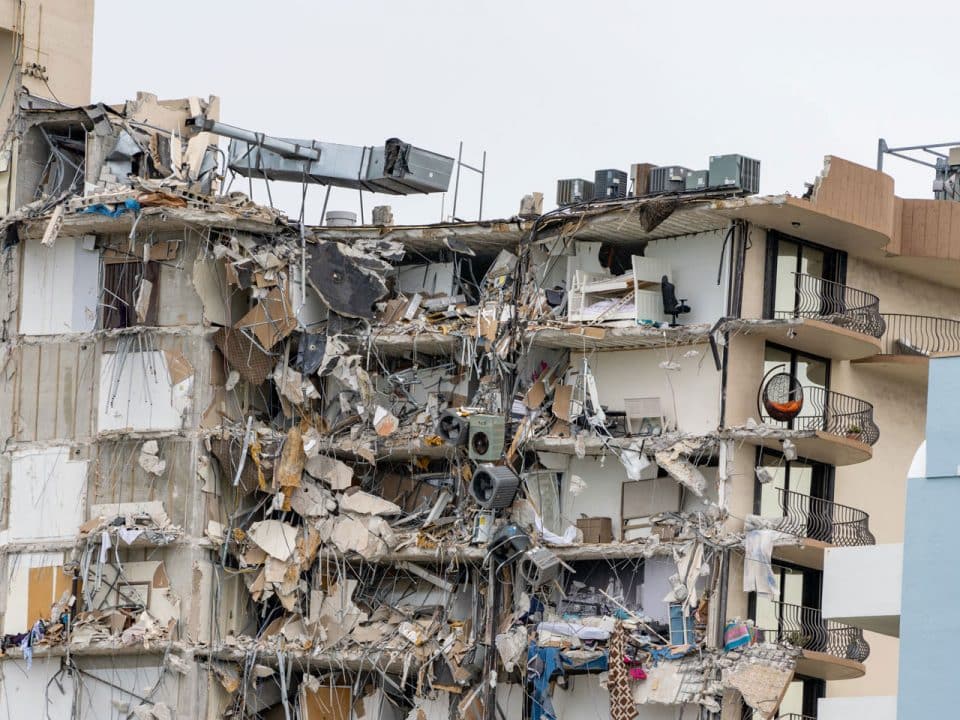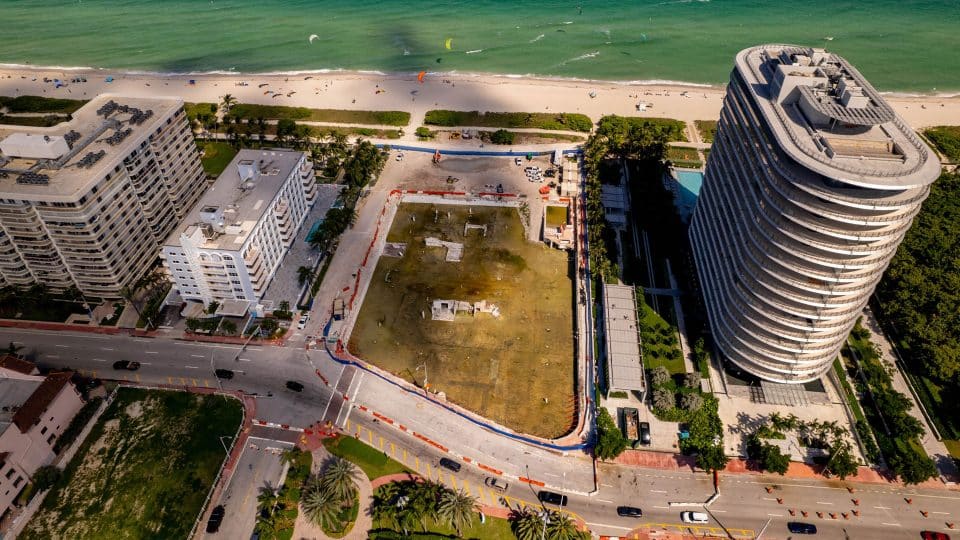
Florida Condominium Market Shows Little Impact Since 2021 Condo Collapse
In the early morning of June 24, 2021, the 12-story Champlain Towers South in Surfside, Florida, suddenly collapsed, killing 98 people. The failure of the 40-year-old condo building immediately generated worldwide attention — and raised questions about the safety of numerous high-rise condo buildings in South Florida and throughout the state. What caused the sudden failure of Champlain Towers South and did the collapse indicate other similar structures were in danger?
Several possible causes for the collapse have been singled out, including saltwater corrosion of rebar, water leaks and deferred maintenance. The Miami Herald reported that “design failures, shoddy construction, damage and neglect lined up like dominoes to create the perfect conditions for a deadly chain reaction.”
The National Institute of Standards and Technology (NIST) launched an investigation to determine why the building fell. While the investigation is ongoing, NIST said “there are millions of high-rise condominium units in Florida alone, many of them aging structures near the ocean. While a NIST investigation is intended to identify the cause of the Champlain Towers South collapse, it could also uncover potential issues in other similar buildings nearby and throughout the nation.”
In response to the building’s collapse, the Florida Legislature convened in a special session in May to pass Senate Bill 4-D, a condo safety bill that significantly changed the recertification process for condominiums three stories or taller, particularly for those near the ocean. Additionally, they established new rules requiring condominium associations maintain enough money in reserves to cover eventual structural repairs.
Consequently, one would expect such a catastrophic event to impact the condominium market, due to safety concerns and the higher costs associated with owning or living in condo units. In an analogous topic, researchers have investigated potential impacts of natural disasters, such as hurricanes and floodings, on local real estate prices. Results indicate that prices can move either way, although only slightly and temporarily. These effects are generally attributed to a tightening of the market due to the destruction of units or to a perception of higher risk.
Analysis of price and transaction trends
In order to investigate whether the Surfside collapse had a noticeable impact on the condominium market, we analyzed the trend in prices and number of transactions of condominium units in Florida using the Zillow Transaction and Assessment Dataset (ZTRAX), a large real estate database. First, we focused on the aggregate market of the South Florida counties of Miami-Dade, Broward and Palm Beach. Figure 1 presents the trend in median prices and number of transactions of condominium units from January 2018 to March 2022, our most recent data. The vertical dashed lines represent, respectively, the date the World Health Organization announced the beginning of the COVID-19 pandemic, and the date of the Surfside collapse.
Beginning of pandemic, March 2020. Collapse of tower, June 24, 2021.
Figure 1 – Source: Zillow Transaction and Assessment Dataset (ZTRAX)
While the pandemic had an immediate impact on the number of transactions, this effect was short-lived and, in fact, the market heated up in the subsequent months, with a marked increase in price and sales volume. Interestingly, volume peaked in the months leading up to the building collapse but had already started to trend down before the tragedy. Although the collapse may have accentuated this decline, prices showed only a small and short dip lasting roughly six months, and then reversed to their original trend upwards, which suggests that there was little impact on the overall market.

Given that Champlain Towers South was undergoing its 40-year inspection when it came down, it is reasonable to suspect that any reaction by the market would be more pronounced for older buildings. In Figures 2 and 3, we compared the trends in the number of transactions and median prices for units in buildings at least as old as Champlain Towers South (built on 1981 or before) and newer buildings (built after 1981). Perhaps unexpectedly, there was no noticeable difference in sales volume after the collapse between older vs. newer buildings. This suggests that the decline in transactions that had begun in the second quarter of 2021 was uniform with respect to a building’s age. Moreover, if there was an effect of the collapse, it seems to have affected more the prices of units in newer buildings.
Beginning of pandemic, March 2020. Collapse of tower, June 24, 2021.
Figure 2 – Source: Zillow Transaction and Assessment Dataset (ZTRAX)
Beginning of pandemic, March 2020. Collapse of tower, June 24, 2021.
Figure 3 – Source: Zillow Transaction and Assessment Dataset (ZTRAX)

Next, we narrowed our analysis to focus on the beachfront communities[1] of Miami-Dade County, which feature a high number of units in high-rise buildings. This is the market where we would expect a relatively larger impact, given that buildings are exposed to the same environmental conditions as the Champlain Towers complex. In Figure 4, our results show again that a decline in the volume of transactions was already underway when the collapse occurred, and that prices remained relatively stable throughout. Moreover, the number of transactions stabilized at a level higher than the period of 2018 to 2020, which suggests that the market has remained relatively strong from a long-term perspective. Conversely, we broadened our focus to the entire state of Florida, and the patterns closely mirror what we observed for the greater Miami area, suggesting no special impact on the South Florida market (Figure 5).
Beginning of pandemic, March 2020. Collapse of tower, June 24, 2021.
Figure 4 – Source: Zillow Transaction and Assessment Dataset (ZTRAX)
Beginning of pandemic, March 2020. Collapse of tower, June 24, 2021.
Figure 5 – Source: Zillow Transaction and Assessment Dataset (ZTRAX)
Lastly, in order to provide a comparative perspective, we present an analysis for the single-family home market in a collection of selected inland counties[2], as an example of a submarket that should be largely unaffected by the Surfside collapse. As expected, both prices and volume of transactions remained steady in the months before and after the event (Figure 6).
Beginning of pandemic, March 2020. Collapse of tower, June 24, 2021.
Figure 6 – Source: Zillow Transaction and Assessment Dataset (ZTRAX)

Taken together, our analyses suggest that the collapse has not substantially impacted the condominium market as one might have expected. This indicates that current residents, owners and prospective buyers may be willing to consider the tragedy an isolated event. In fact, 13 months after the building’s collapse, a Dubai-based developer paid $120 million to buy the valuable two-acre oceanfront site at 8777 Collins Ave. Unsurprisingly, the buyer plans to build a luxury residential condo building on the property.
“We are planning to put up the most luxurious, the highest standard of condominiums in North America and in the world on that [site],” Hussain Sajwani told a reporter for the Real Deal, a real estate news outlet.
Footnotes:
- South, Mid, and North Beach, Fisher Island, Surfside, Bal Harbour and Sunny Isles Beach. Back to content
- Alachua, Clay, Lake, Leon, Marion, Orange, Osceola, Polk and Seminole counties. Back to content